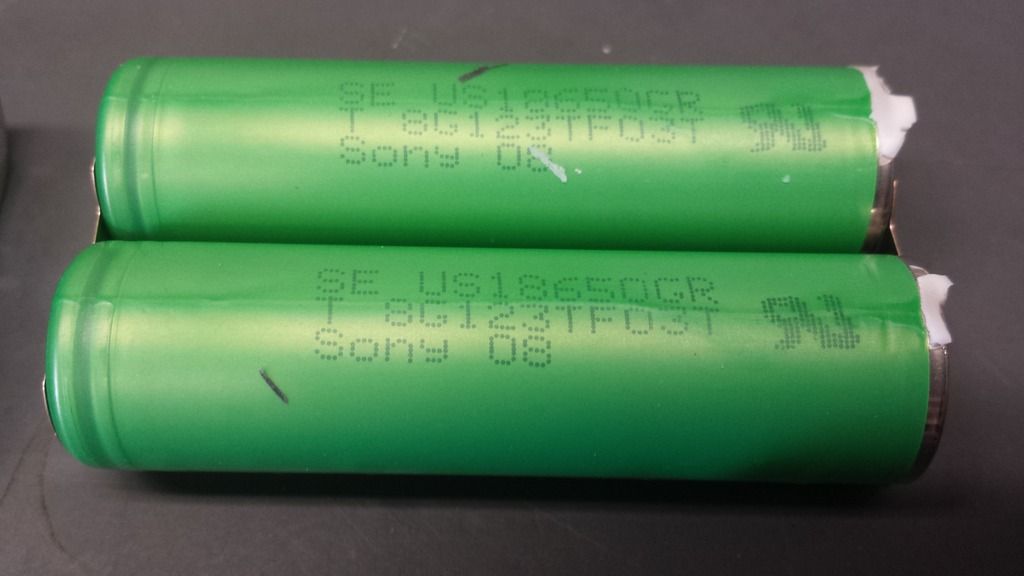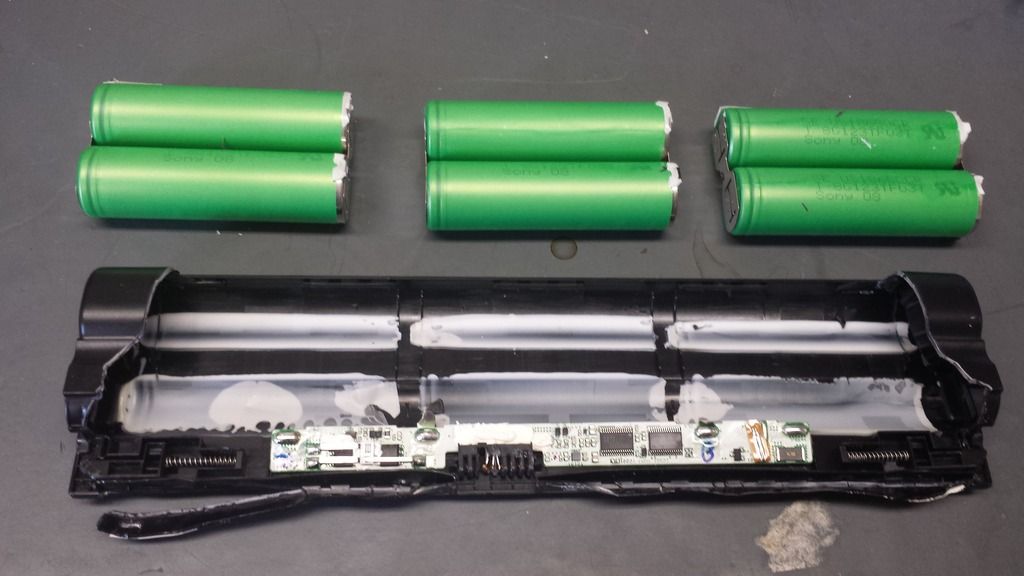I finally got around to disassembling the NOS 12” iBook pack my previous post. BTW, I see a lot of people using dremel tools, etc… to break into these cases. I haven’t read through the whole thread to see if anyone else is using the method I use, but for the most part, I’m able to get into these packs with my bare hands and just a few hand tools in the end (leatherman and diagonal pliers), applying very minimal forces on the packs.
Table Data and pics before disassembly:
Apple, M9337G/A, mAh not listed but calculated as 5100 mAh (2x2550)@10.8 v (3x3.6), SF (Sony Fukushima?) US18650GR, 2550Mah


Based on the output voltage (10.8v) I’m expecting 3 cells (3 x 3.6v). Based on the dimensions of the pack, I’m expecting 6 18650s, so 3 pairs (3x3.6v), each pair welded in parallel (2x2550mAh). Volts and Amps multiplied gives us wattage (Power), so total power output in the range of 18.4 watts (18.36 rounded up).
Disassembly:
Most of the battery packs (HP/Apple/Dell/Asus/Acer/Toshiba) that I’ve examined to date are built in this fashion: Basically the main frame is a skeletonized plastic clamshell with a large window (ribbed or not) which is sealed by a thin, stick-on plastic or metallic plate. In the picture below, if you look at the upper right corner of the cell, you can see where I’ve folded back the corner of the plate, revealing the green battery inside the pack. Funny coincidence, in the youtube video by Ol-Lumen in the OP, he disassembles what looks to be an Acer Netbook battery which does NOT have the plate I spoke of.

Peeling back the plastic plate completely reveals:

Using my fingers, I was able to pry open one side of the ribs, tear it free, then work the remaining ribs off, revealing the batteries below:

Flipping the pack over, by flexing the pack slightly, I was able to remove the cover on the bottom of the pack:

With the inner ribs removed, I then pried off one of the long side retainers, which then allowed me to carefully extract the two pairs of inner cells.

I used the diagonal pliers to trim the leads to avoid shorts and then removed the last 2 cells. I used the needle nose of my leatherman to remove as much of the welded battery tabs as possible. I then used a sanding drum on my cordless drill to remove the remnants (because I couldn’t find my dremel). In this battery pack, Apple uses a silicone based compound as an adhesive, which made clean up a breeze. A little spit and elbow grease and we have the finished product:

Note that the battery pairs are welded in parallel, positive to positive, negative to negative. This doubles the current capacity, basically turning two 3.7 v x 2550 mAh cells into effectively a 3.7 v x 5100 mAh cell. 3 of these paired cells are then wired in series (positive to negative) which then triples (3 cells) the pack voltage (Apple uses 3.6 volts in their calculation, apparently, so 3 x 3.6) to 10.8 v.
Imprinting on the cells:
SF US18650GR
T G7141OI12I
Based on the 20th post in this link, I’m assuming these are 2400 mAh batteries, build date 2006, September 12.
Charged the individual cells via leads connected to my Opus charger, then ran a capacity test which yielded the following mAh/internal resistance results:
2544/103 2535/97 2501/116 2569/98 2549/96 2507/90, with all batteries charging up to between 4.17-4.19 volts, so I’m pretty happy with the results.
BTW, I’ve been doing this for a few weeks now so still very wet behind the ears. Initially, I was recording data directly onto the batteries, however I was noticin a couple of issues. It was difficult to write on the round batteries. I could only record limited data. The permanent marker I was using was rubbing off easily.
To address these issues, I created a google sheet into which I recorded what I considered to be pertinent information. I wiped down each battery with rubbing alcohol to remove any possible grease, and then I assigned a 2 digit hexadecimal code for each battery which I wrote on each battery using metallic permanent marker. I then covered the marking with a piece of clear tape. You’d be surprised how long that will protect such markings.
Anyway, I made a copy of my spreadsheet and it’s available to the public for comment here. I would appreciate any comments or feedback. Also, if anyone else finds it is useful, by all means, feel free to make a copy for yourself and distribute it freely.
For now, the batteries go into a holding plastic container, placed in a firesafe. In 5 days time, I’ll check the voltages against my data table to compare losses.
Mahalo












